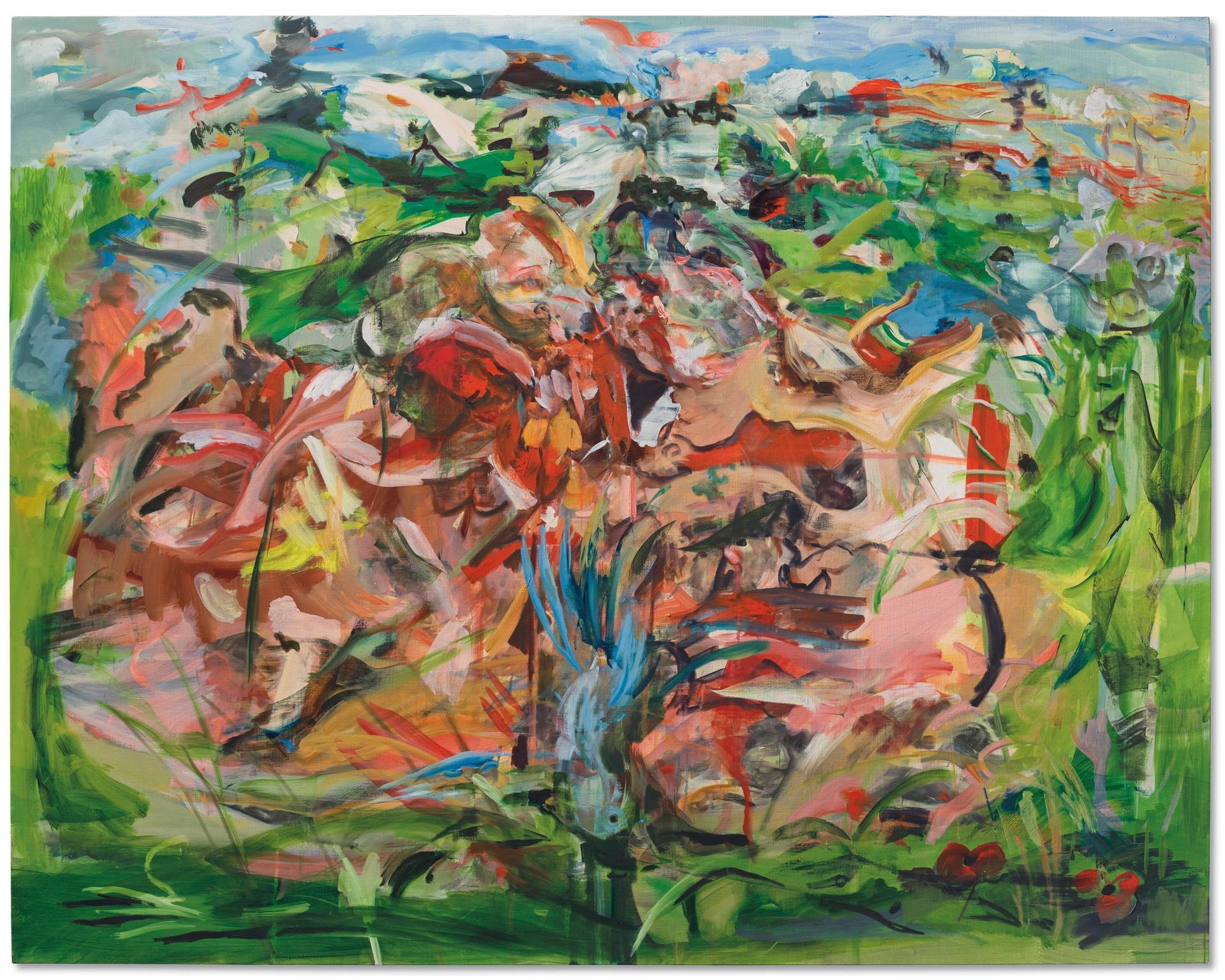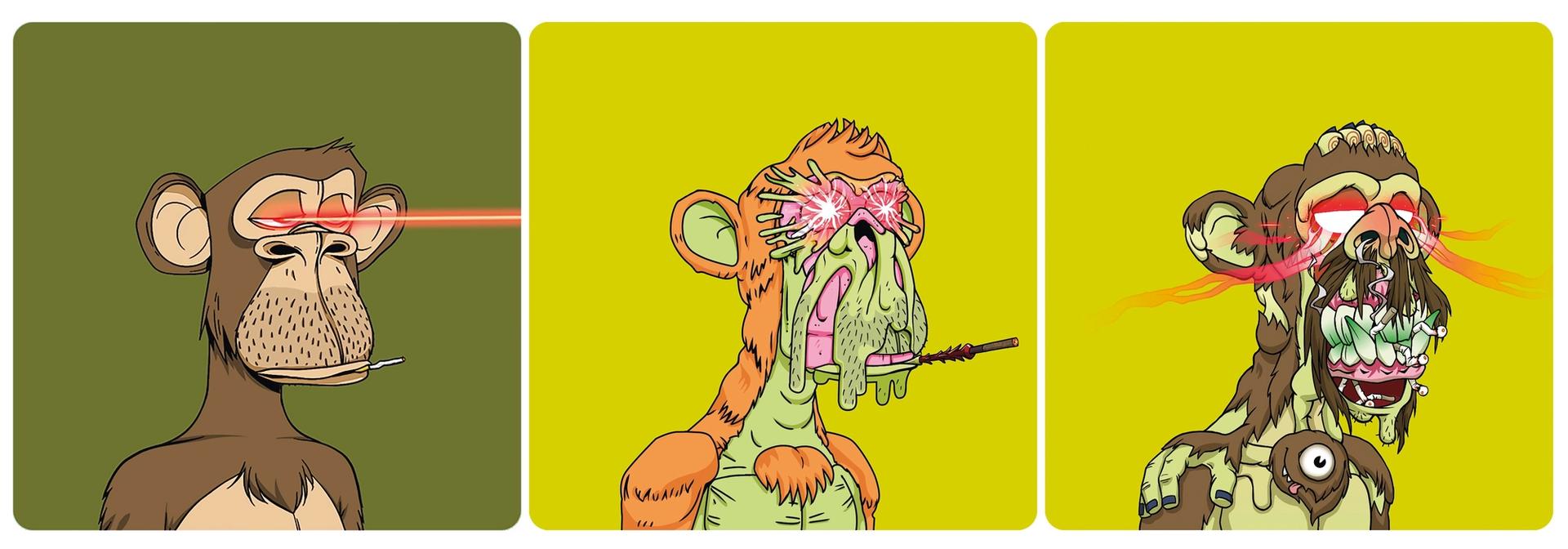The first non-fungible token to come to auction in Europe—and only minted in September—sold for just shy of one million pounds to a bidder sat in the room at a Christie’s auction in London today.
A triptych of NFTs from the Bored Ape Yacht Club (BAYC)—one of the most popular NFT projects online—sold for £982,500 (with fees) after a quick flurry of bids.
The buyer may have caught a wave. On Tuesday, the collective Yuga Labs, the creators of BAYC, announced they had signed with the agency Maverick, which represents pop artists including Britney Spears and Madonna.
The successful bidder now owns three of the roughly 10,000 algorithmically generated bored apes which, together, traded $132.2m during peak sales in August according to The Block.
More traditional works of art also turned heads at Christie’s 20/21st Century Evening Sale, which contained 38 lots, including many major 21st century artists, and was the first fully attended in-person event to be held since the onset of the pandemic.
The first lot of the sale, a figurative painting from 2019 by the British artist Cecily Brown, which was donated by the artist and her gallery Thomas Dane Gallery, was estimated at £500,000 but went for £2.9m (£3.5m with fees) after a sustained bidding war from buyers from three continents. Proceeds from the sale will go to ClientEarth, an environmental charity Christie’s is partnering with in collaboration with Gallery Climate Coalition. Brown was the most prominent of a strong showing of female painters at the auction, with works by Shara Hughes, Hilary Precis and Emily Mae Smith all far exceeding their estimates.

Cecily Brown's There'll be Bluebirds (2019)
Courtesy of Christie's
But the auction's star was Audition, a 1998 painting of a swimming pool scene by the 56-year-old British-Jamaican painter Hurvin Anderson, who hails from Birmingham and is also represented by Dane. Anderson’s work sparked a heated back and forth between multiple bidders in London and from the phones in the US and Hong Kong. Estimated at up to £1.5m, the painting sold for a record £6.2m (£7.4m with fees), bid by a buyer phoning in from New York. Anderson’s work is currently on show as part of the Hayward Gallery’s Mixing It Up exhibition in London and is the subject of a solo show at Dane's gallery in London.
Such enthusiasm for beautiful painting created by mid-career artists reflects a current zeitgeist, the advisor Melanie Clore says.
"We’ve come out of a very challenging time,” Clore says. “People have been cooped up. There’s a euphoria and an optimism to the moment, and that’s reflected in the freshness and vitality and enthusiasm of these beautiful new paintings.”
Clore, previously chairperson of Sotheby’s Europe until 2016 and now co-founder of the art advisory group Clore Wyndham, notes the Christie’s sale came off the back of a very strong showing at Sotheby’s equivalent auction on Thursday for young artists like Jadé Fadojutimi, Ewa Juszkiewicz and, most notably, Flora Yukhnovich, the 31-year-old British artist from Norwich who graduated from the City & Guilds of London Art School as recently as 2017. Her painting I’ll have what she’s having, created in 2020, shattered expectations to sell for £2.3m. At Christie's today, Hilary Pecis’ 2019 painting Kaba On A Chair sold for £180,000 (£225,000 with fees) against a high estimate of £60,000, whilst Emily Mae Smith’s 2017 Paint While Screaming sold for £95,000 (£118,750 with fees), nearly four times the high estimate.

Yuga Labs’ MAYC, or Mutant Ape Yacht Club
Courtesy of Christie's
“There’s the energy of youth present to these creations,” Clore says. “The fact they were painted very recently does not deter people. There’s a surge of interest in this kind of work from young and mid-career painters, and that’s resulting in very strong prices. Even though there isn’t the same depth of knowledge of the secondary market for this work, collectors are still taking the opportunity to acquire them.”
But the art advisor Bona Montagu sounded a note of caution: “Auction houses are very careful and canny about the lots they choose to bring to market,” she says. “For some time, we have been seeing a preponderance of material by emerging, sought-after artists being put up for sale. The auction houses know they’re going to instigate a lot of interest and bidding for work that is hard to secure on the primary market.”
This comes with incumbent risks, Montagu says. “I’m a bit concerned to see how much these young artists are being pushed at auctions like this,” she says. “They’re still early in their careers. By creating these price levels, they are encouraging investors to buy art in the hope they will similarly inevitably increase enormously in value. That isn’t necessarily good for the artists.”
In contrast to heady bidding for young painters, there were some disappointments for established names. Hockney’s Guest House Garden, a painting from 2000 which some commentators expected to fly, sold for £5m (£5.8m with fees) on an estimate of up to £7m, whilst Peter Doig’s Hill Houses, estimated at up to £3.5 to £4.5m, failed to sell. A Rudolf Stingel painting from 2012, estimated at £1m, was withdrawn.
Christie’s reported 35% of buyers were from Asia. There was 50% increase in buyers under 40, year on year. In all, 90% of the lots sold for a total of £64.6m (with fees), below a pre-sale high estimate (without fees) of £66.4m.
“We judged the season well. We brought the right material,” a spokesperson told The Art Newspaper.


